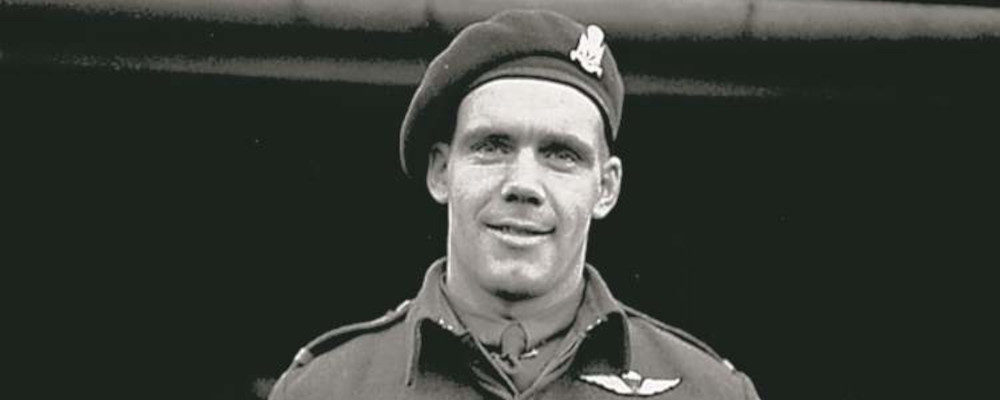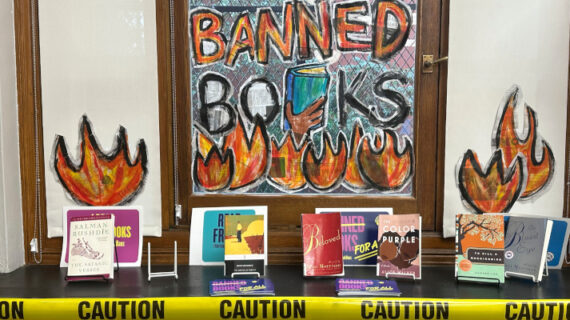After 9/11 NFL football player Pat Tillman did something extraordinary. A linebacker with the Arizona Cardinals, he left behind his multi-million-dollar contract and joined the U.S. Army. He was later deployed to Iraq only to be killed by friendly fire. Tillman, a muscular, square-jawed Adonis right out of central casting for the role of all-American hero, was 27. His story got featured on 60 Minutes, there was a movie, and he’d receive, posthumously, the Silver Star and Purple Heart. Americans know Pat Tillman.
The attack on the World Trade Center was unquestionably the geopolitical event of the past quarter-century—until Russia invaded Ukraine and everything changed. As it did when Nazi Germany invaded Poland in 1939. The lesson still not learned is about appeasing ruthless dictators, but here we are with images of war-torn Europe—an eerie reminder of World War II.
Canada has its own Pat Tillman and his name is Jeff Nicklin. Nicklin was also a pro football player, one who recognized that his values and way of life were under attack. But despite his military record people in this country know nothing about him.
There is a black-and-white photo of Nicklin in uniform. The man who led the 1st Canadian Parachute Battalion, which played a huge role in history’s biggest war, has a beret on his head and the wings of the battalion over his heart. Like Tillman, he was square-jawed and strapping, but certainly not menacing in the picture. He looks pleasant and at ease, his lips parted in a friendly grin, but his eyes stare right into you and speak.
Tell them about me and what we did.
Lest we forget.
Nicklin was in charge of training, and later Commanding Officer, of a remarkable Canadian unit. Indeed, Hollywood has immortalized the deeds of lesser men. He was born in Fort William, Ontario on December 10, 1914, shortly after the outbreak of the Great War—World War I—but grew up in Winnipeg. A gifted athlete in basketball, hockey, and lacrosse, he made his mark in football. In 1935 Nicklin was with the Winnipeg Blue Bombers of the Western Interprovincial Football Union, a forerunner of the Canadian Football League. That year the team became the first from the west to win the Grey Cup. They won again in 1939 and by then Nicklin was a three-time all-star who like many players of the day was a two-way man; he played offensive and defensive end.
I learned about him and his battalion doing research for a novel about two lovers caught in the Battle of Normandy after D-Day. And I’m ashamed I knew nothing about him or the paratroopers.
World War II began September 1, 1939, with Germany invading Poland. Britain and France declared war and Canada, a member of the British Commonwealth, was there at the outset. The football season was already in full swing with the playoffs looming. The Blue Bombers, which finished first in their group with a 10-2 record, went on to win the Grey Cup on December 9. Not long afterward Nicklin packed in football and enlisted with the Royal Winnipeg Rifles, a crack infantry regiment. He was in his mid-20s, at the peak of his career, and twice a Grey Cup champion. But like Pat Tillman after 9/11, Nicklin had his moment of reckoning. His unit went to England to train and the officers liked what they saw. They would eventually put him in command of a group called Baker Company.
The 1st Canadian Parachute Battalion was created in July 1942. It was something new, an airborne regiment. Nicklin applied along with his friend Fraser Eadie, a noted hockey player. The aspiring paratroopers trained at Fort Benning in Georgia and Camp Shiloh in Manitoba. Those who couldn’t hack it were cut—like on a football team—and many were. In August 1943, the ones who made it were back in England at Carter Barracks in Bulford, northwest of London, training for a mission: a mammoth Allied invasion of Europe.
By this time Nicklin was second-in-command of the battalion, and in charge of training. The former pro athlete was demanding where football and the military were concerned. Along with weapons training and sharpshooting, fitness was a priority. That meant a two-mile run every morning before breakfast. Ten-mile runs in full battle gear with weapons which had to be done in under two hours. And 50-mile forced marches.
Nicklin often led those runs, showing up in an old Blue Bombers sweatsuit. He usually finished first. The idea was to build endurance, both mental and physical, and put these men in the best shape of their lives.
On February 13, 1944, Canadian and American troops found a novel way to build camaraderie. Those who had played college and pro football staged a game—the Tea Bowl—at White City Stadium in London. More than 30,000 people attended, staving off the cold with rum. The game was broadcast on radio across the British Isles, and Spitfires from the Royal Air Force guarded airspace around the stadium to repel any attack from the German Luftwaffe. The Canadian team—the Mustangs—defeated the U.S. Army Central Base Station Pirates 16-6 with Nicklin scoring a touchdown on the final play. But many players from that game wouldn’t survive the war.1“Respecting the English hosts, a one-off gridiron game was organized between Canadian and American forces – the “Tea Bowl”. With a 6-week preparation, a squadron of Spitfires on guard, an audience of over 32,000 confused spectators who all had to be given an abridged copy of the rules of the game, (and who more importantly had flouted the obvious danger of convening in one place), the Canadian ‘Mustangs’ – as they called themselves, defeated the Americans, winning 16-6.” http://canadasports150.ca/en/military-teams/the-tea-bowl-and-the-1944-grey-cup-champions/97
D-Day. June 6, 1944. The Allied invasion of Europe with 156,000 soldiers storming the beaches of Normandy. The Canadians would take Juno Beach. But something has been largely ignored by our historical conscience, the thousands of Allied paratroopers dropped in the dark of night hours before that invasion. The 1st Canadian Parachute Battalion encompassed 541 men, including 50 Indigenous, from around the country. They were the first Canadians to set foot in German-occupied France that memorable day, Nicklin among the first to jump.
They went in after midnight with 30-kilogram supply bags tied to their bodies, the Germans shooting from below. They had to land in the Drop Zone, but many came down far from their marks due to the relentless enemy onslaught and the all-consuming chaos of thousands of men and aircraft. D-Day would involve more than 10,000 Allied planes. Then there was the water. The Germans had flooded the Normandy swamplands, and lots of paratroopers drowned when they hit the drink, weighed down by their gear, while others were shot dead. Casualties were high.2“On D-Day, Canadians suffered 1074 casualties, including 359 killed.” https://www.warmuseum.ca/cwm/exhibitions/chrono/1931d_day_e.html#:~:text=On%20D%2DDay%2C%20Canadians%20suffered,1074%20casualties%2C%20including%20359%20killed.
Their mission? Seize and hold French villages held by the Germans, destroy bridges, and take out arteries that could bring German reinforcements to the beaches. They had to protect those beaches.
Nicklin landed in the middle of an enemy position at the village of Varaville, which would be the scene of Canada’s first victory over the Germans in the war. His parachute got snared on a rooftop, but according to one report, the hefty Nicklin dangled down the side of a wall as the Germans scurried about, shooting at him. He cut himself loose, took cover, and rejoined his unit an hour later.
For three months they fought in the Battle of Normandy, and helped liberate French towns and villages, but lost 24 officers and 343 men. Nicklin was wounded by shrapnel at Le Mesnil, a place known as the Crossroads and a strategic point for any occupying force. He was evacuated to a hospital in England. On November 10, 1944, the football player who began his military career as a private only to advance to lieutenant, captain, and major, was promoted again to lieutenant-colonel. He became Commanding Officer of the battalion with his pal Major Eadie second in command. Nicklin had a wife back home and on their wedding anniversary he sent a cable mentioning the promotion and said he was recovering from his wounds.
“He was always testing himself,” said Cliff Chadderton who served with Nicklin in the Royal Winnipeg Rifles and played hockey with him on the regiment team. “Testing Jeff Nicklin with whatever the world wanted to throw at him.”
Chadderton, a D-Day veteran who lost part of his right leg in Belgium in 1944 at the Battle of the Scheldt, died in his nineties in 2013. A member of the Order of Canada, he was interviewed for a War Amps documentary about Nicklin called Jeff Nicklin: Hero of the Gridiron and the Battlefield.
On Christmas Eve, 1944, a reorganized battalion went to Belgium with CO Nicklin leading them in the Battle of the Bulge, an operation where the Germans tried to split Allied forces. It was the biggest land battle of the war with over a million men. The paratroopers were the only Canadians in it. Then on March 24, 1945, with Nazi Germany making a last-ditch stand, the Allies launched Operation Varsity, history’s greatest airborne operation conducted on a single day.
More than 16,000 American, British, and Canadian paratroopers were flown over the Rhine River and dropped into Nazi Germany. But unlike D-Day it was daytime and they had but ten minutes to hit their marks. The Canadians had to seize and hold a wooded area where the main landing assault would take place. Then the Allies would march on Berlin. The mission succeeded, the Canadians met their objectives within two hours, and casualties were deemed light. But Nicklin was among them.
He insisted on being one of the first to jump. As he came down, his chute became tangled in a tree. Said one news report: “Vicious German infantrymen shot him as he hung helpless far above the ground. His men who held him in same esteem as doting football crowds once did, will not forget that.”
He was reported missing and two days later they found his body riddled with bullets, still suspended from the tree. The star athlete in charge of training, the battalion CO, was 30 years old with a young wife and an infant son, Jeff Jr., whom he never met. The parachute would serve as his shroud, his final resting place at Groesbeek Canadian War Cemetery in the Netherlands. Nicklin is one of 2,338 Canadians buried there.
The Toronto Daily Star of March 31, 1945, had an article about him that began like this: “Some 30 paratroopers who had made their last jump lay side by side today in a neat row outside the small brick church on the edge of the cemetery by the woods at Bergen. They lay shrouded in gray blankets, that is, all but one and he the biggest of them, was wrapped in his brown parachute. This was Jeff Nicklin of Winnipeg, former rugby star of the Blue Bombers.”
Another piece appeared in The Ottawa Citizen: “Husky Lt. Col J. A. ‘Jeff’ Nicklin, commander of the 1st Canadian Parachute Battalion, and outstanding Canadian football star and pride of Winnipeg Blue Bombers, has plunged into the line for the last time.”
Fraser Eadie assumed command of the battalion and led the men on a march to Wismar on the Baltic coast. Along the way, they took thousands of German POWs. They penetrated further into Germany than any other Canadian fighting force in the war. When it was over the battalion, The War Amps, and the league later called the Canadian Football League dedicated a trophy—the Jeff Nicklin Memorial Trophy—awarded to the Most Valuable Player in the Western Conference. This trophy is still awarded today.3“The Jeff Nicklin Memorial Trophy for the Canadian Football League West Division’s most valuable player is named in his honour. Nicklin was inducted into the Manitoba Sports Hall of Fame in 2004. Sportswriter Vince Leah placed Nicklin atop his list of all-time greatest Winnipeg players in A History of the Blue Bombers.” https://military-history.fandom.com/wiki/Jeff_Nicklin
Nicklin was posthumously appointed an Officer of the Order of the British Empire. The citation concluded with these words: “Throughout the present campaign his example of courageous leadership has been an example to all who have come into contact with him.”
On February 17, 1945—five weeks before Operation Varsity—British Brigadier James Hill prepared a Special Confidential Report on Lt-Col J. A. Nicklin. Hill was commander of Britain’s 3rd Parachute Brigade, and the 1st Canadian Parachute Battalion reported to him.
Question number three: Has he carried out his duties satisfactorily? Response: Very satisfactorily. The next question was about Nicklin’s personality and characteristics. This is what Hill said:
“An officer of the highest integrity who possesses unusual drive and determination. He sets a very high standard in the Bn and is prepared to accept no compromise. He is a stern disciplinarian but takes infinite trouble to safeguard the welfare of the men.”
In a twist of fate, Fraser Eadie wound up marrying Nicklin’s widow after losing his wife. Eadie, who also rose to Lieutenant-Colonel, lived to 86 and she to 92. His obituary in 2003 included the names of his children and grandchildren, the surname Nicklin appearing several times.
Everything I have learned about Jeff Nicklin—his early life, military records, newspaper reports, National Archives Canada documents, a website about the battalion4“The 1st Canadian Parachute Battalion Preservation Association (HQ) is a nonprofit living history organization dedicated to the study and memory of the original battalion that served so well during the Second World War.” https://www.1canpara.org/ that is run by an American, and The War Amps documentary—all point to the same thing. The guy was a hero. A pro athlete who gave it up to fight.
Which brings me to Canada, a country uneasy with heroes and reluctant to embrace them, especially those from the military. The most famous is World War I flying ace Billy Bishop whose number of enemy kills—the official tally of aircraft he downed is 72—has come into dispute and even discredit.5“Billy Bishop is widely known as the top Canadian flying ace of the First World War, boasting 72 victories and numerous accolades. He was an Air Marshal and the recipient of many medals. During the Second World War, he was a key player in the implementation of the British Commonwealth Air Training Plan.” https://www.veterans.gc.ca/eng/remembrance/people-and-stories/billy-bishop It’s like an asterisk is beside his name. Or how about Francis Pegahmagabow, a Canadian Ojibwe who was the number one sharpshooter from any nation in that same war. But we don’t know him.6“Francis Pegahmagabow was one of the most highly decorated Indigenous soldiers of the First World War. An Ojibwa from the Parry Island Band in Ontario, he was awarded the Military Medal plus two bars for acts of bravery in Belgium and France.” https://www.veterans.gc.ca/eng/remembrance/people-and-stories/francis-pegahmagabow
I think this is wrong-headed, as are those who are quick to topple statues and monuments or cry FREEDOM at the top of their lungs when they have known only comfort, not captivity, in their lives. They look at history through the prism of the present. Indeed, until a few weeks ago who could have imagined a major war in Europe?
But here we are. I sit glued to the TV watching what’s happening in Ukraine as the world condemns. And still, it goes on. I see citizens defying tanks on city streets. Apartment buildings blown to bits. Children—cancer patients unable to get treatment—hovering in a hospital basement turned bomb shelter. Millions fleeing their country and a savage dictator bent on genocide.
This is Europe in 2022.
We should not besmirch nor forget heroes, and be mindful of the cost of our freedoms. This is not cliché. But it dismays me when I see how little the current generation knows about history.
I think about these things when I look at Jeff Nicklin and he stares back. In one photo he’s wearing his paratrooper uniform, in another football gear with CANADA across the chest. I want to tell him that the last surviving member of his battalion—Lou Lamy—died October 17, 2021, in Calgary. He was 96. He left his wife of 75 years, four children, eight grandchildren, and 15 great-grandchildren. Even in his later years, he attended paratrooper reunions at the 1st Canadian Parachute Battalion Monument in Siffleur Falls, Alberta.
Nicklin would be saddened by the news but could take comfort in Lamy leading such a long and fruitful life. And looking at the photo I can hear the words of the battalion commander. I hear them clear as a bell.
He earned it.




